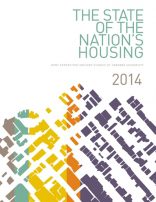I had the opportunity to participate in a recent webcast about the Harvard Joint Center for Housing Studies’ report, State of the Nation’s Housing, where I talked about the nation’s affordability challenges, and was challenged to think about why we don't hear about them more.
Half of all renters—or more than 20 million households—are cost burdened, meaning they spend more than 30 percent their income each month on rent. Eleven million renters spend more than half of their income on housing. The number of cost burdened renters increased by 38 percent between 2002 and 2012.
Trends in housing costs and incomes have dovetailed to drive these affordability numbers. Rents are rising as incomes have remained relatively flat. Rising rents are due to increased demand from the large millenial and baby boomer populations, many who are “renters by choice,” as well as demand from former or would-be homeowners who have become “renters by necessity,” unable to access homeownership. Fast-rising rents are coupled with slow wage growth. During the economic recovery, lower-wage jobs have replaced some higher-wage jobs, which has resulted in stagnant incomes.
While the shares of cost burdened households are greatest in the recovering, high-cost markets on the coasts and in parts of Texas, there is no part of the country immune from housing affordability challenges. Indeed, in our own recent report on housing affordability and working families, we found that in 21 states, at least one in five low- and moderate-income working families was spending more than half of their income on housing.almost no one is immune from economic challenges and uncertainty. During the housing bust, hundreds of thousands of families lost their homes to foreclosure and millions more were substantially under water. At the worst of the recession, the unemployment rate peaked at 10 percent. Everyone knew someone hit by the economic downturn—a family member, a neighborhood, a co-worker. This was a problem very much for “us.”
While rental affordability is still a major hurdle for lower-income households, it is a problem that is also moving up the economic ladder. Nationally, over 71 percent of renters with household incomes below $15,000—about what a minimum wage worker earns working full-time—are severely cost burdened. Federal housing assistance programs designed to help low-income families and individuals only reach one out of four eligible households, which means we must continue to press for greater resources to help those most in need.
But increasingly, higher income households are unable to find affordable housing too. In Miami, Chicago, New Orleans, New York, Washington, D.C.—all around the country—middle-class individuals and families are forced to pay a greater share of their income on rent. Or they are finding they need to live further away from their jobs and spend more on transportation. As the housing affordability challenge scales the economic ladder, it becomes more likely that we will all know someone personally who struggles to find affordable housing. It could be our child’s teacher, the person who fixes our car, or the nurse who cares for our mother. It could be our neighbor or our relative. Or it could be us. When it is “us” and not “them,” an issue gains traction, and I think that’s what has happened to some extent with the rental affordability issue.
My question, then, is how can we use this growing awareness—and further expand the attention to housing affordability—to build support for public- and private-sector solutions?
If it’s not “their” problem but rather “our” problem, there is a growing opportunity to draw more—and different—people into the discussions around increasing housing supply, preserving existing affordable housing, and maintaining and expanding government programs and policies that have been successful in expanding the availability of affordable housing.





Comments